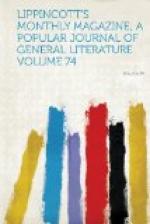The chambers are frequently massed around four sides of a stone-paved court, from which direct entrance is had to the main staircases. In some of these flagged spaces a fountain tinkles; in others, sturdy elm- or plane-trees tower far above the red chimney-stacks; in the centre of another is the famous Temple pump. The several courts have distinguishing names, such as Garden Court, Pump Court, and Brick Court, and they connect with each other sometimes by an arched passage under the houses, at two sides of the square, or again by narrow alleys. Nor is the same level always preserved. Small flights of time-worn steps continually surprise us in our pilgrimage. The aggregate—barren courts, narrow passages, and winding lanes—forms a perfect labyrinth, very trying to a stranger or to one possessing a poor memory for localities.
The nomenclature of certain of these Temple courts possesses a breezy, countrified sound, utterly unsuggestive of musty tomes and special pleadings. Thus, we have Elm-Tree Court, Vine Court, Fig-Tree Court, and Fountain Court. The reader will recall to mind the fact that it was in the last-named locality, with its sprightly, sparkling, upward-springing stream, that Ruth Pinch—“gentle, loving Ruth”—held tryst with her lover, manly John Westlock. Letitia Elizabeth Landon, too, has embalmed this “pet and plaything of the Temple” in some pleasant stanzas:
The fountain’s
low singing is heard on the wind,
Like a melody
bringing sweet fancies to mind,—
Some to grieve,
some to gladden: around them they cast
The hopes of the
morrow, the dreams of the past.
Away in the distance
is heard the vast sound
From the streets
of the city that compass it round,
Like the echo
of fountains, or the ocean’s deep call;
Yet that fountain’s
low singing is heard over all.
Entering the houses, we find them mostly of a stereotyped pattern. A wainscoted, dark, and generally uncarpeted staircase gives access to landings on which abut the outer doors of the “sets,” or chambers. These consist of two, three, or at most four rooms, in the style peculiar to the domestic architecture of the earlier years of the present century. High corniced ceilings, wainscoted walls, and shoulder-high chimney-pieces abound. Here and there, however, some opulent tenant has modernized his rooms; but the structures, inside and out, remain for the most part not materially changed from the later Georgian era of their erection,—a time when every gentleman sported a small-sword and ladies wore hoops and patches. The famous garden forms one of the chief charms of the Temple enclosure, and its beauty and atmosphere of quiet repose are justly celebrated. Here Shakespeare is believed to have sat and thought out some of his most masterly creations; here many of the great legal luminaries of the last few centuries walked and talked; and here the infantile footsteps




